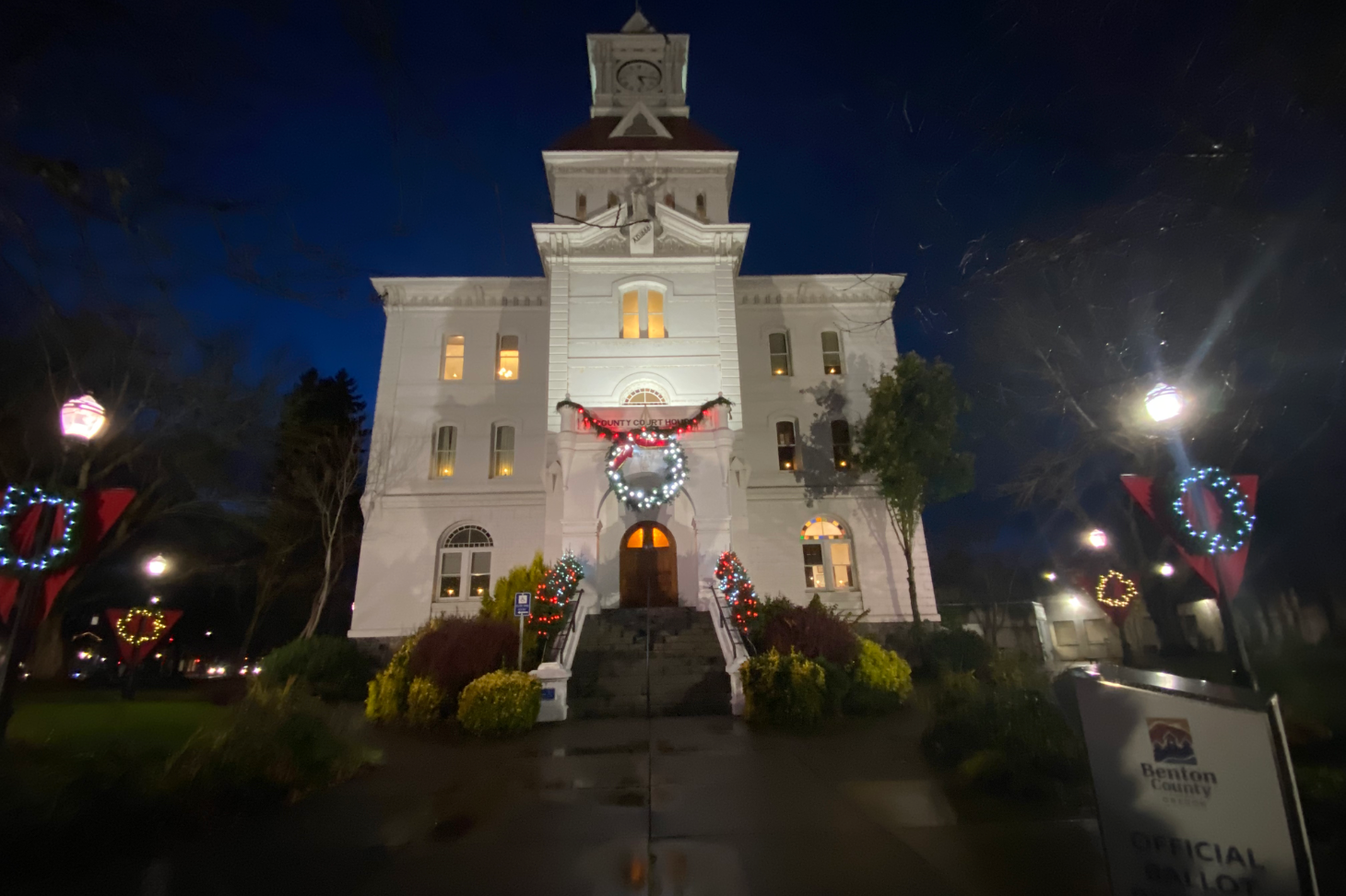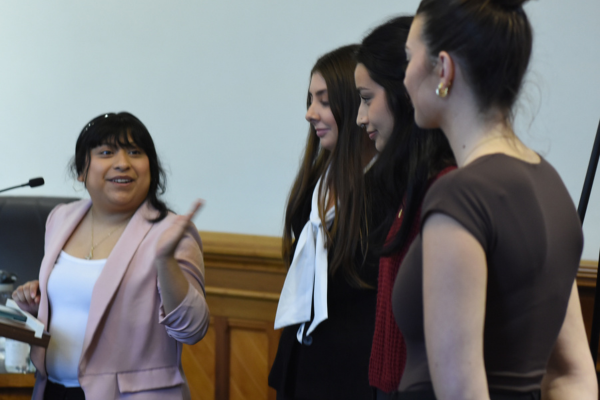News, articles, and interesting stuff from the College of Business

It was an unusual sight for a Wednesday afternoon in December: The Benton County Courthouse was abuzz with students and longtime Corvallis residents alike. The students, part of the College of Business’s selective, admission-only interior design program, were there to present their ideas for repurposing the courthouse, which the county says has outgrown its current functionality.
The question of what to do with the building is not hypothetical, nor made up for coursework: Benton County is in early stages of investigating what to do with the courthouse when its functions are eventually moved elsewhere.
Though it may seem like an unexpected collaboration, community engagement is a core tenet of OSU’s interior design program. In a past term, for instance, students worked with a local church to design affordable housing units for community members experiencing homelessness.
Completed in 1889, the Benton County Courthouse is the oldest county courthouse in Oregon still being used for its original purpose. It was listed on the National Register of Historic Places in 1977, so demolition is not an option, nor is it desired.
“The courthouse is an iconic symbol and presence in Benton County,” said Brenda Downum ‘87, who leads communications and community engagement in partnership with the Benton County Historic Courthouse Advisory Committee. “It’s in a great downtown location. People care about it.”
The Historic Courthouse Advisory Committee has narrowed down possible uses for the building to three concept buckets: government and civic use; arts, education and culture; or a mixed-use combination of these.
That’s where the students came in.
Students enrolled in Studio III Design Communication – taught by David Jacobs, a licensed architect, an instructor in the College of Business and OSU’s campus space allocation manager – were given these parameters and a courthouse tour. They did not have to consider cost feasibility or practical construction issues. Instead, they were tasked with unleashing their full creativity on the space.
Students first worked individually on their own concepts, with county stakeholders providing feedback at midterm. Then, students formed groups and merged their plans together. Each student’s original idea was assigned to a single floor of the courthouse.
“Their concepts might not fit together on paper,” Jacobs said, “but having to work with dissonant ideas is really helpful in design and helps create very interesting spaces.”
Anel Gutierrez Ignacio, a junior in her first term in the interior design program, looked to her own love of photography for inspiration. For her floor, she envisioned art studio space to rent and a gallery spotlighting local artists, which would even allow the county to generate some revenue, she said.

Students ultimately presented their work, showcased on large displays they created, to a public meeting of the Historic Courthouse Advisory Committee in early December. Throughout the presentations, committee members asked questions and spoke excitedly about the students’ ideas.
“I heard a lot of, ‘That’s what I was thinking! Now we can see what it might look like,’ and, ‘I hadn’t thought of that, and it’s fantastic,’” said Chris W. Westfall ‘92, Trial Court Administrator for Oregon’s 21st Judicial District and chair of the HCAC.
Gutierrez Ignacio’s group-mates proposed a ground-floor museum featuring interactive exhibits on the Willamette River and the history of Corvallis, a gathering hall with a childcare center that could host events like weddings, and a top-floor bar and social hub. Many groups’ concepts followed a similar theme, integrating the history of the space and the region with contemporary design and function.
“It was wonderful to see OSU students in this space and involved in the process,” said Downum. From here, Downum will include a summary of the students’ work in a report that details the HCAC’s recommendations for the courthouse’s future for the Benton County Board of Commissioners.
When the courthouse might actually change is uncertain, as its repurposing is contingent on moving county courts to a new Justice Center. The final design and funding sources for that project have yet to be determined. However, the need for an updated facility remains, Westfall said, as does a community-approved plan for the existing building.
No matter what happens – no matter how the courthouse ends up being repurposed – these students’ contributions were fundamental, Westfall said. “They are now a big part of this history. Their perspectives are forever embedded in the future of the courthouse.”
The project was also an opportunity for students to engage with members of the broader Corvallis community, and vice versa. “Seeing the older population of community members interacting with students, and taking them seriously, plus the quality of thoughtful ideas from students – it was a beautiful thing,” Westfall said.
Gutierrez Ignacio is primarily interested in residential design, which was sparked by following her mother to housecleaning jobs as a kid. Many of the homes were elaborate, she said, and they showed her that living spaces could be beautiful and functional. Though this project with the courthouse has opened her eyes to the possibilities of working in commercial design, too, her ultimate dream is driven by a desire to give back.
“It might be crazy, but I want to move to Brazil,” she said. “There are really low-income communities there called favelas. My parents came from somewhere similar. Often they don’t have running water or plumbing. It’s really bad. I want to use design to give people the basics that everybody needs to have. I want more people to feel proud of where they live.”
Once students are accepted into the interior design program, they’re able to learn design principles alongside effective business practices, Jacobs said. They do so in a range of educational formats.
“This studio format is unique,” Jacobs said. “This fall course focuses on real-world projects within the community. These projects, often intricate and demanding, compel students to delve into the societal impact of their work, transcending mere classroom exercises.”
According to Marilyn Read Ph.D., associate professor, Laura B. Smith Faculty Scholar and the head of the interior design program, this practical approach helps students immensely once they reach the job market.
“We routinely hear from interior design professionals that they are pleased with the students’ knowledge of business practices,” Read said.
As for these students, they’re already well on their way to success, Westfall said.
“I can’t speak highly enough of the work they presented,” he said of the December presentations. “They stood shoulder-to-shoulder with established professionals. It was remarkable.”
Story by Jess Kibler